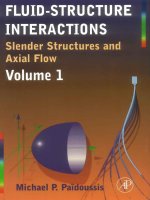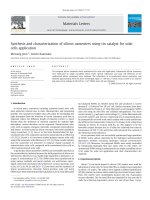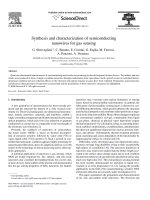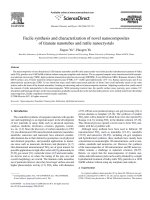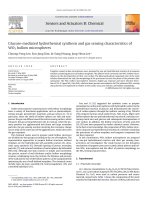fattorusso - modern alkaloids - structure, isolation, synthesis and biology (wiley, 2008)
Bạn đang xem bản rút gọn của tài liệu. Xem và tải ngay bản đầy đủ của tài liệu tại đây (7.67 MB, 691 trang )
Modern Alkaloids
Edited by
Ernesto Fattorusso and
Orazio Taglialatela-Scafati
Related Titles
Tietze, Lutz F. / Eicher, Theophil / Diederichsen, Ulf / Speicher, Andreas
Reactions and Syntheses
in the Organic Chemistry Laboratory
2007
ISBN: 978-3-527-31223-8
Hudlicky, Tomas / Reed, Josephine W.
The Way of Synthesis
Evolution of Design and Methods for Natural Products
2007
ISBN: 978-3-527-31444-7
Sarker, Satyajit / Nahar, Lutfun
Chemistry for Pharmacy Students
2007
ISBN: 978-0-470-01780-7
Kayser, Oliver / Quax, Wim J. (eds.)
Medicinal Plant Biotechnology
From Basic Research to Industrial Applications
2006
ISBN: 978-3-527-31443-0
Eicher, Theophil / Hauptmann, Siegfried
The Chemistry of Heterocycles
Structure, Reactions, Syntheses, and Applications
2003
ISBN: 978-3-527-30720-3
van de Waterbeemd, Han / Lennerna
¨
s, Hans / Artursson, Per (Eds.)
Drug Bioavailability
Estimation of Solubility, Permeability, Absorption and Bioavailability
2003
ISBN: 978-3-527-30438-7
Hesse, Manfred
Alkaloids
Nature’s Curse or Blessing?
2002
ISBN: 978-3-906390-24-6
Modern Alkaloids
Structure, Isolation, Synthesis and Biology
Edited by
Ernesto Fattorusso and Orazio Taglialatela-Scafati
The Editors
Prof. Ernesto Fattorusso
Univ. Federico II Dipto. di
Chimica delle Sost. Naturali
Via D. Montesano 49
80131 Napoli
Italien
Prof. O. Taglialatela-Scafati
Univ. Federico II, Dipto. di
Chimica delle Sost. Naturali
Via D. Montesano 49
80131 Napoli
Italien
All books published by Wiley-VCH are carefully
produced. Nevertheless, authors, editors, and
publisher do not warrant the information contained
in these books, including this book, to be free of
errors. Readers are advised to keep in mind that
statements, data, illustrations, procedural details or
other items may inadvertently be inaccurate.
Library of Congress Card No.:
applied for
British Library Cataloguing-in-Publication Data
A catalogue record for this book is available from the
British Library.
Bibliographic information published by
the Deutsche Nationalbibliothek
Die Deutsche Nationalbibliothek lists this publica-
tion in the D eutsche Nationalbibliografie; detailed
bibliographic data are available in the Internet at
.
# 2008 WILEY-VCH Verlag GmbH & Co. KGaA,
Weinheim
All rights reserved (including those of translation
into other languages). No part of this book may be
reproduced in any form – by photoprinting,
microfilm, or any other means – nor transmitted or
translated into a machine language without written
permission from the publishers. Registered names,
trademarks, etc. used in this book, even when not
specifically marked as such, are not to be considered
unprotected by law.
Typesetting Thomson Digital, Noida
Printing betz-druck GmbH, Darmstadt
Binding Litges & Dopf GmbH, Heppenheim
Cover Design Grafik-Design Schulz,
Fußgo
¨
nheim
Printed in the Federal Republic of Germany
Printed on acid-free paper
ISBN: 978-3-527-31521-5
Contents
Preface XVII
List of Contributors XIX
I Bioactive Alkaloids: Structure and Biology 1
1 Ecological Roles of Alkaloids 3
Michael Wink
1.1 Introduction: Defense Strategies in Plants 3
1.2 Ecological Roles of Alkaloids 4
1.3 Modes of Action 9
1.3.1 Unspecific Interactions 11
1.3.2 Specific Interactions 12
1.3.3 Cytotoxicity of Alkaloids 16
1.4 Evolution of Alkaloidal Defense Systems 19
1.5 Conclusions 23
2 Antitumor Alkaloids in Clinical Use or in Clinical Trials 25
Muriel Cuendet, John M. Pezzuto
2.1 Introduction 25
2.2 Antitumor Alkaloids in Clinical Use 25
2.2.1 Vinca Alkaloids 25
2.2.1.1 Vinblastine (VLB, 1) 28
2.2.1.2 Vincristine (VCR, 2) 28
2.2.1.3 Vindesine (VDS, 3) 28
2.2.1.4 Vinorelbine (VRLB, 4) 29
2.2.1.5 Vinflunine (VFL, 5) 29
2.2.2 Camptothecin and Analogs 29
2.2.2.1 Camptothecin (CPT, 6) 31
2.2.2.2 Irinotecan (CPT-11) 31
2.2.2.3 Topotecan 32
2.2.2.4 Exatecan 32
2.2.2.5 Gimatecan 32
Modern Alkaloids: Structure, Isolation, Synthesis and Biology. Edited by E. Fattorusso and O. Taglialatela-Scafati
Copyright ß 2008 WILEY-VCH Verlag GmbH & Co. KGaA, Weinheim
ISBN: 978-3-527-31521-5
V
2.2.2.6 Karenitecin 32
2.2.2.7 Lurtotecan 32
2.2.2.8 Rubitecan (9-nitrocamptothecin) 33
2.2.3 Taxanes 33
2.2.3.1 Paclitaxel 33
2.2.3.2 Docetaxel 35
2.3 Antitumor Alkaloids in Clinical Trials 36
2.3.1 Ecteinascidin-743 (Yondelis, Trabectedin) 36
2.3.2 7-Hydroxystaurosporine (UCN-01) 37
2.3.3 Ellipticine and Analogs 37
2.3.4 Acronycine and Analogs 38
2.3.5 Colchicine and Analogs 39
2.3.6 Ukrain 40
2.4 Alkaloids Used for MDR Reversal 40
2.4.1 Cinchona Alkaloids 40
2.4.2 Dofequidar Fumarate (MS-209) 41
2.5 Alkaloids Used for Cancer Prevention 42
2.6 Conclusions 43
2.7 Acknowledgments 44
3 Alkaloids and the Bitter Taste 53
Angela Bassoli, Gigliola Borgonovo, Gilberto Busnelli
3.1 Introduction 53
3.2 The Bitter Taste Chemoreception Mechanism 54
3.3 Bitter Alkaloids in Food 58
3.4 The Bitter Taste of Alkaloids in Other Drugs and Poisons 63
3.5 Alkaloids and Taste in Insects 66
3.6 The Bitter Taste of Alkaloids: Should We Avoid, Mask, or
Understand? 69
3.7 Acknowledgments 70
4 Capsaicin and Capsaicinoids 73
Giovanni Appendino
4.1 Introduction 73
4.2 What Is an Alkaloid? Is Capsaicin an Alkaloid? 73
4.3 Diversity, Biosynthesis, and Metabolism of Capsaicinoids 77
4.4 Quantization of Capsaicinoids and Their Distribution in Chili
Pepper 83
4.5 Isolation and Synthesis of Capsaicin 86
4.6 TRV1 as the Biological Target of Capsaicin and the Ecological Raison
d’e
ˆ
tre of Capsaicinoids: A Molecular View 90
4.7 Naturally Occurring Analogs and Antagonists of Capsaicin
and Endogenous Vanilloids 93
4.8 Structure–Activity Relationships of Capsaicinoids 94
VI Contents
4.9 Molecular Gastronomy of Hot Food 98
4.9.1 Biomedical Relevance of Capsaicin-Induced Trigeminal
Responses 98
4.9.2 Effect of Capsaicin on Taste 98
4.9.3 Gustatory Sweating 99
4.9.4 Gustatory Rhinitis 99
4.9.5 Hot Food Mitridatism 99
4.9.6 Effect of Capsaicin on Digestion 100
4.9.7 Capsaicin and Stomach Cancer 100
4.9.8 The Effect of Age and Sex on the Sensitivity to Capsaicin 100
4.9.9 Capsaicin as a Slimming Agent 101
4.9.10 Quenching Capsaicin 101
4.9.11 Chilies and Olive Oil 102
4.9.12 Who Should Avoid Chilies? 102
4.9.13 How can the Pungency of Chilies be Moderated? 102
4.9.14 Psychology of Pepper Consumption 102
4.10 Conclusions 103
4.11 Acknowledgments 103
5 Glycosidase-Inhibiting Alkaloids: Isolation, Structure, and
Application 111
Naoki Asano
5.1 Introduction 111
5.2 Isolation and Structural Characterization 111
5.2.1 Deoxynojirimycin and Related Compounds 112
5.2.1.1 Isolation from Morus spp. (Moraceae) 112
5.2.1.2 Isolation from Thai Medicinal Plants ‘‘Thopthaep’’ and ‘‘Cha
Em Thai’’ 113
5.2.2 a-Homonojirimycin and Related Compounds 115
5.2.2.1 Isolation from Garden Plants 115
5.2.2.2 Isolation from the Thai Medicinal Plant ‘‘Non Tai Yak’’ 117
5.2.2.3 Isolation from Adenophora spp. (Campanulaceae) 117
5.2.3 Indolizidine and Pyrrolizidine Alkaloids 117
5.2.3.1 Isolation from the Leguminosae Family 118
5.2.3.2 Isolation from the Hyacinthaceae Family 120
5.2.4 Nortropane Alkaloids 122
5.2.4.1 Isolation from the Solanaceae Family 123
5.2.4.2 Isolation from the Convolvulaceae Family 124
5.3 Biological Activities and Therapeutic Application 125
5.3.1 Antidiabetic Agents 125
5.3.1.1 a-Glucosidase Inhibitors 125
5.3.1.2 Glycogen Phosphorylase Inhibitors 128
5.3.1.3 Herbal Medicines 128
5.3.2 Molecular Therapy for Lysosomal Storage Disorders 129
Contents VII
5.3.2.1 Substrate Reduction Therapy 130
5.3.2.2 Pharmacological Chaperone Therapy 130
5.4 Concluding Remarks and Future Outlook 133
6 Neurotoxic Alkaloids from Cyanobacteria 139
Rashel V. Grindberg, Cynthia F. Shuman, Carla M. Sorrels, Josh Wingerd,
William H. Gerwick
6.1 Introduction 139
6.2 Neurotoxic Alkaloids of Principally Freshwater and Terrestrial
Cyanobacteria 141
6.2.1 Anatoxin-a, Homoanatoxin-a, Anatoxin-a(s), and Analogs 141
6.2.1.1 Anatoxin-a 142
6.2.1.2 Homoanatoxin-a 145
6.2.1.3 Anatoxin-a(s) 145
6.2.2 b-Methylaminoalanine 146
6.2.3 Saxitoxin 151
6.3 Neurotoxic Alkaloids of Marine Cyanobacteria 156
6.3.1 Antillatoxin A and B 156
6.3.2 Jamaicamide A, B, and C 158
6.3.3 Kalkitoxin 161
6.4 Conclusion 162
7 Lamellarin Alkaloids: Structure and Pharmacological Properties 171
Je
´
ro
ˆ
me Kluza, Philippe Marchetti, Christian Bailly
7.1 Introduction 171
7.2 The Discovery of Lamellarins 172
7.3 Modulation of Multidrug Resistance 174
7.4 Antioxidant Properties 176
7.5 Inhibition of HIV-1 Integrase 176
7.6 Cytotoxicity 177
7.7 Topoisomerase I Inhibition 178
7.8 Targeting of Mitochondria and Proapoptotic Activities 180
7.9 Conclusion 184
8 Manzamine Alkaloids 189
Jiangnan Peng, Karumanchi V. Rao, Yeun-Mun Choo, Mark T. Hamann
8.1 Introduction 189
8.2 Manzamine Alkaloids from Marine Sponges 191
8.2.1 b-Carboline-containing Manzamine Alkaloids 191
8.2.1.1 Manzamine A Type 191
8.2.1.2 Manzamine B Type 195
8.2.1.3 Manzamine C Type 196
8.2.1.4 Other b-Carboline-containing Manzamines 196
8.2.2 Ircinal-related Alkaloids 198
8.3 Source and Large-scale Preparation of Manzamine Alkaloids 202
VIII Contents
8.3.1 Source of Manzamine Alkaloids 202
8.3.2 Large-scale Preparation of Manzamines 204
8.3.3 Supercritical Fluid Chromatography Separation of Manzamine
Alkaloids 205
8.4 Synthesis of Manzamine Alkaloids 206
8.4.1 Total Synthesis of Manzamine A and Related Alkaloids 206
8.4.2 Total Synthesis of Manzamine C 208
8.4.3 Total Synthesis of Nakadomarin A 214
8.4.4 Synthetic Studies of Manzamine Alkaloids 216
8.4.5 Studies on Biomimetic Synthesis 217
8.4.6 Synthesis of Manzamine Analogs 219
8.5 Biological Activities of Manzamines 220
8.5.1 Anticancer Activity 220
8.5.2 Antimalarial Activity 222
8.5.3 Antimicrobial and Antituberculosis Activity 224
8.5.4 Miscellaneous Biological Activities 225
8.6 Concluding Remarks 226
9 Antiangiogenic Alkaloids from Marine Organisms 233
Ana R. Diaz-Marrero, Christopher A. Gray, Lianne McHardy, Kaoru Warabi,
Michel Roberge, Raymond J. Andersen
9.1 Introduction 233
9.2 Purine Alkaloids 235
9.3 Terpenoid Derivatives 236
9.3.1 Avinosol 236
9.3.2 Cortistatins A–D 237
9.3.3 Squalamine 238
9.4 Motuporamines 240
9.5 Pyrrole-Imidazole Alkaloids: ‘‘Oroidin’’-Related Alkaloids 244
9.5.1 Agelastatin A 245
9.5.2 Ageladine A 247
9.6 Tyrosine-derived Alkaloids 250
9.6.1 Aeroplysinin-1 250
9.6.2 Psammaplin A 254
9.6.3 Bastadins 256
9.7 Tryptophan-derived Alkaloids 259
9.8 Ancorinosides 262
9.9 Concluding Remarks 263
10 A Typical Class of Marine Alkaloids: Bromopyrroles 271
Anna Aiello, Ernesto Fattorusso, Marialuisa Menna,
Orazio Taglialatela-Scafati
10.1 Introduction 271
10.2 Oroidin-like Linear Monomers 273
10.3 Polycyclic Oroidin Derivatives 278
Contents IX
10.3.1 C-4/C-10 Derivatives 278
10.3.2 N-1/C-9 Derivatives 281
10.3.3 N-7/C-11 þ N-1/C-12 Derivatives 281
10.3.4 N-7/C-11 þ C-4/C-12 Derivatives 284
10.3.5 N-1/C-12 þ N-7/C-12 Derivatives 285
10.3.6 N-1/C-9 þ C-8/C-12 Derivatives 285
10.4 Simple or Cyclized Oroidin-like Dimers 286
10.5 Other Bromopyrrole Alkaloids 291
10.6 Conclusions 296
11 Guanidine Alkaloids from Marine Invertebrates 305
Roberto G.S. Berlinck, Miriam H. Kossuga
11.1 Introduction 305
11.2 Modified Creatinine Guanidine Derivatives 305
11.3 Aromatic Guanidine Alkaloids 307
11.4 Bromotyrosine Derivatives 309
11.5 Amino Acid and Peptide Guanidines 310
11.6 Terpenic Guanidines 320
11.7 Polyketide-derived Guanidines 321
II New Trends in Alkaloid Isolation and Structure Elucidation 339
12 Analysis of Tropane Alkaloids in Biological Matrices 341
Philippe Christen, Stefan Bieri, Jean-Luc Veuthey
12.1 Introduction 341
12.2 Extraction 343
12.2.1 Plant Material 343
12.2.2 Supercritical Fluid Extraction 343
12.2.3 Microwave-assisted Extraction 344
12.2.4 Pressurized Solvent Extraction 345
12.2.5 Solid-phase Microextraction 345
12.2.6 Biological Matrices 346
12.3 Analysis of Plant Material and Biological Matrices 348
12.3.1 Gas Chromatography 348
12.3.2 High-performance Liquid Chromatography 355
12.3.3 Capillary Electrophoresis 359
12.3.4 Desorption Electrospray Ionization Mass Spectrometry 361
12.4 Conclusions 362
13 LC-MS of Alkaloids: Qualitative Profiling, Quantitative Analysis,
and Structural Identification 369
Steven M. Colegate, Dale R. Gardner
13.1 Introduction 369
13.2 LC-MS Overview 369
X Contents
13.2.1 Optimization 370
13.2.1.1 Modification of Mobile Phases and Ionization Parameters 370
13.2.1.2 HPLC Versus UPLC 372
13.2.1.3 Fluorinated HPLC Solid Phases 372
13.2.1.4 Reduction of Ion Suppression 373
13.3 Clinical Chemistry and Forensic Applications 374
13.3.1 Extraction and Analytical Considerations 375
13.3.2 Forensic Detection of Plant-derived Alkaloids 375
13.3.2.1 Plant-associated Intoxications 375
13.3.2.2 Illicit Drug Use: Multiple Reaction Monitoring 376
13.3.2.3 Quality Control of Herbal Preparations: APCI-MS 376
13.4 Metabolite Profiling and Structure Determination 376
13.4.1 LC-MS/MS Approaches to the Identification/Structural Elucidation
of Alkaloid Drug Metabolites 377
13.4.1.1 Tandem MS 377
13.4.1.2 Accurate Mass Measurement 378
13.4.1.3 Chemical Modification 378
13.4.2 Minimization of Sample Treatment 378
13.4.3 Structure Determination 380
13.4.3.1 Nudicaulins from Papaver nudicaule:
High-resolution MS 380
13.4.3.2 Endophyte Alkaloids: An MS Fragment Marker 380
13.5 Pyrrolizidine Alkaloids and Their N-Oxides 382
13.5.1 Solid Phase Extraction 383
13.5.2 Qualitative Profiling 383
13.5.2.1 Echium plantagineum and Echium vulgare 385
13.5.2.2 Senecio ovatus and Senecio jacobaea 387
13.5.3 Quantitative Analysis 392
13.5.3.1 Calibration Standards 393
13.5.3.2 Honey 394
13.6 Alkaloids from Delphinium spp. (Larkspurs) 395
13.6.1 Flow Injection (FI) Mass Spectrometry 396
13.6.1.1 Qualitative FI Analysis 397
13.6.1.2 Quantitative FI Analyses 398
13.6.1.3 Chemotaxonomy of Delphinium Species 399
13.6.2 LC-MS Analysis of Diterpene Alkaloids 400
13.6.2.1 Toxicokinetics and Clearance Times 400
13.6.2.2 Diagnosis of Poisoning 401
13.6.3 Structural Elucidation of Norditerpenoid Alkaloids 402
13.6.3.1 Stereochemical Indications 402
13.6.3.2 Isomeric Differentiation Using Tandem Mass
Spectrometry 403
13.6.3.3 Novel Diterpene Alkaloid Identification: Application of Tandem
Mass Spectrometry 405
13.7 Conclusions 405
Contents XI
14 Applications of
15
N NMR Spectroscopy in Alkaloid Chemistry 409
Gary E. Martin, Marina Solntseva, Antony J. Williams
14.1 Introduction 409
14.1.1
15
N Chemical Shift Referencing 409
14.1.2
15
N Chemical Shifts 411
14.1.3
15
N Reviews and Monographs 411
14.2 Indirect-Detection Methods Applicable to
15
N 412
14.2.1 Accordion-optimized Long-range
1
H–
15
N Heteronuclear Shift
Correlation Experiments 413
14.2.2 Pulse Width and Gradient Optimization 414
14.2.3 Long-range Delay Optimization 414
14.2.4 Establishing F
1
Spectral Windows 416
14.3
15
N Chemical Shift Calculation and Prediction 418
14.3.1 Structure Verification Using a
15
N Content Database 418
14.3.2
15
N NMR Prediction 419
14.3.3 Enhancing NMR Prediction With User-‘‘trained’’ Databases 420
14.3.4 Validating
15
N NMR Prediction 420
14.4 Computer-assisted Structure Elucidation (CASE) Applications
Employing
15
N Chemical Shift Correlation Data 422
14.5 Applications of
15
N Spectroscopy in Alkaloid Chemistry 428
14.6 Applications of Long-range
1
H–
15
N 2D NMR 430
14.6.1 Five-membered Ring Alkaloids 430
14.6.2 Tropane Alkaloids 436
14.6.3 Indoles, Oxindoles, and Related Alkaloids 437
14.6.3.1 Strychnos Alkaloids 437
14.6.3.2 Azaindoles 439
14.6.3.3 Indoloquinoline Alkaloids 439
14.6.3.4 Vinca Alkaloids 441
14.6.3.5 Other Indole Alkaloids 442
14.6.4 Carboline-derived Alkaloids 448
14.6.5 Quinoline, Isoquinoline, and Related Alkaloids 450
14.6.6 Benzo[c]phenanthridine Alkaloids 453
14.6.7 Pyrazine Alkaloids 456
14.6.8 Diazepinopurine Alkaloids 459
14.7 Pyridoacridine, Quinoacridine, and Related Alkaloids 460
14.8 Conclusions 465
III New Trends in Alkaloid Synthesis and Biosynthesis 473
15 Synthesis of Alkaloids by Transition Metal-mediated Oxidative
Cyclization 475
Hans-Joachim Kno
¨
lker
15.1 Silver(I)-mediated Oxidative Cyclization to Pyrroles 475
15.1.1 Synthesis of the Pyrrolo[2,1-a]isoquinoline Alkaloid Crispine A 477
XII Contents
15.1.2 Synthesis of the Indolizidino[8,7-b]indole Alkaloid
Harmicine 478
15.2 Iron(0)-mediated Oxidative Cyclization to Indoles 478
15.3 Iron(0)-mediated Oxidative Cyclization to Carbazoles 481
15.3.1 3-Oxygenated Carbazole Alkaloids 482
15.3.2 Carbazole-1,4-Quinol Alkaloids 483
15.3.3 Furo[3,2-a]carbazole Alkaloids 483
15.3.4 2,7-Dioxygenated Carbazole Alkaloids 485
15.3.5 3,4-Dioxygenated Carbazole Alkaloids 487
15.4 Palladium(II)-catalyzed Oxidative Cyclization to
Carbazoles 488
15.4.1 Carbazolequinone Alkaloids 489
15.4.2 Carbazomadurins and Epocarbazolins 492
15.4.3 7-Oxygenated Carbazole Alkaloids 493
15.4.4 6-Oxygenated Carbazole Alkaloids 495
16 Camptothecin and Analogs: Structure and Synthetic Efforts 503
Sabrina Dallavalle, Lucio Merlini
16.1 Introduction: Structure and Activity 503
16.2 Synthetic Efforts 507
17 Combinatorial Synthesis of Alkaloid-like Compounds In Search
of Chemical Probes of Protein–Protein Interactions 521
Michael Prakesch, Prabhat Arya, Marwen Naim, Traian Sulea,
Enrico Purisima, Aleksey Yu. Denisov, Kalle Gehring, Trina L. Foster,
Robert G. Korneluk
17.1 Introduction 521
17.2 Protein–Protein Interactions 523
17.3 Alkaloid Natural Products as Chemical Probes of Protein–Protein
Interactions 524
17.4 Indoline Alkaloid Natural Product-inspired
Chemical Probes 525
17.4.1 Indoline Alkaloid-inspired Chemical Probes 526
17.4.2 Tetrahydroquinoline Alkaloid-inspired Chemical Probes 528
17.5 Alkaloid Natural Product-inspired Small-molecule Binders to Bcl-2
and Bcl-XL and In Silico Studies 532
17.5.1 Alkaloid Natural Product-inspired Small-molecule Binders to
Bcl-XL and NMR Studies 533
17.5.2 Alkaloid Natural Product-inspired Small-molecule Probes
for XIAP 535
17.5.2.1 Cell Death Assay 535
17.5.2.2 Caspase-3 Activation Assay 536
17.5.2.3 Caspase-9 Release Assay 536
17.5.3 Summary and Future Outlook 536
17.6 Acknowledgments 538
Contents XIII
18 Daphniphyllum alkaloids: Structures, Biogenesis, and Activities 541
Hiroshi Morita, Jun’ichi Kobayashi
18.1 Introduction 541
18.2 Structures of Daphniphyllum Alkaloids 542
18.2.1 Daphnane-type Alkaloids 542
18.2.2 Secodaphnane-type Alkaloids 543
18.2.3 Yuzurimine-type Alkaloids 543
18.2.4 Daphnilactone A-type Alkaloids 543
18.2.5 Daphnilactone B-type Alkaloids 544
18.2.6 Yuzurine-type Alkaloids 544
18.2.7 Daphnezomines 545
18.2.8 Daphnicyclidins 551
18.2.9 Daphmanidins 557
18.2.10 Daphniglaucins 559
18.2.11 Calyciphyllines 560
18.2.12 Daphtenidines 560
18.2.13 Other Related Alkaloids 561
18.3 Biosynthesis and Biogenesis 564
18.3.1 Biosynthesis of Daphniphyllum Alkaloids 564
18.3.2 Biogenesis of the Daphnane and Secodaphnane Skeletons 564
18.3.3 Biogenesis of the Daphnezomines 565
18.3.4 Biogenesis of the Daphnicyclidins 568
18.3.5 Biogenesis of the Daphmanidins 569
18.3.6 Biogenesis of the Daphniglaucins 570
18.3.7 Biogenesis of the Calyciphyllines 573
18.3.8 Biogenesis of the Daphtenidines 573
18.4 Synthesis 575
18.4.1 Biomimetic Chemical Transformations 575
18.4.1.1 Transformation of an Unsaturated Amine to the Daphnane
Skeleton 575
18.4.1.2 Transformation of Daphnicyclidin D to Daphnicyclidins E and J 575
18.4.2 Biomimetic Total Synthesis 576
18.4.2.1 Methyl Homosecodaphniphyllate and Protodaphniphylline 576
18.4.2.2 Secodaphniphylline 579
18.4.2.3 Methyl Homodaphniphyllate and Daphnilactone A 580
18.4.2.4 Codaphniphylline 582
18.4.2.5 Bukittinggine 583
18.4.2.6 Polycyclization Cascade 583
18.5 Activities 585
18.6 Conclusions 586
19 Structure and Biosynthesis of Halogenated Alkaloids 591
Gordon W. Gribble
19.1 Introduction 591
19.2 Structure of Halogenated Alkaloids 591
XIV Contents
19.2.1 Indoles 591
19.2.2 Carbazoles 596
19.2.3 b-Carbolines 596
19.2.4 Tyrosines 598
19.2.5 Miscellaneous Halogenated Alkaloids 603
19.3 Biosynthesis of Halogenated Alkaloids 605
19.3.1 Halogenation Enzymes 605
19.3.2 Indoles 606
19.3.3 Biosynthesis of Halogenated Tyrosines 609
19.3.4 Biosynthesis of Miscellaneous Alkaloids 612
20 Engineering Biosynthetic Pathways to Generate Indolocarbazole
Alkaloids in Microorganisms 619
Ce
´
sar Sa
´
nchez, Carmen Me
´
ndez, Jose
´
A. Salas
20.1 Introduction 619
20.2 Studies Made Before the Identification of Biosynthetic Genes 620
20.3 Identification of Genes Involved in Indolocarbazole Biosynthesis 621
20.3.1 Genes Involved in Rebeccamycin Biosynthesis 621
20.3.2 Genes Involved in Staurosporine Biosynthesis 625
20.3.3 Genes Involved in Biosynthesis of Other Indolocarbazoles 625
20.4 Indolocarbazole Biosynthetic Pathways and Their Engineering 626
20.4.1 Tryptophan Modification 626
20.4.2 Formation of Bisindole Pyrrole 627
20.4.3 Formation of Carbazole 630
20.4.4 Formation of the Sugar Moiety 632
20.4.4.1 Sugar Moieties in Rebeccamycin and AT2433 632
20.4.4.2 The Staurosporine Sugar Moiety 634
20.4.5 Regulation and Self-resistance 636
20.5 Perspectives and Concluding Remarks 637
20.6 Acknowledgments 638
Index 641
Contents XV
Preface
Alkaloids constitute one of the widest classes of natural products, being synthesized
practically by all phyla of both marine and terrestrial organisms, at any evolutionary
level. The extraordinary variety (and often complexity) of alkaloid structures and
biological properties have long intrigued natural product chemists (for structure
determination and biosynthetic studies), analytical chemists, and synthetic organic
chemists. Toxicologists, pharmacologists and pharmaceutical companies have used
and will certainly continue to use alkaloids as biological tools and/or as lead
compounds for development of new drugs.
When we started our project of a handbook on alkaloid science, we were faced
with an impressive number of papers describing the structures and activities of
alkaloids, and also with an intense review activity, published in excellent book series
or in single books covering specific classes of alkaloids. Consequently, we decided to
organize our handbook to present the different aspects of alkaloid science (e.g. the
structure and pharmacology of bioactive alkaloids; recent advances in isolation,
synthesis, and biosynthesis) in a single volume, aiming to provide representative
examples of more recent and promising results as well as of future prospects in
alkaloid science. Obviously, the present handbook cannot be regarded as a compre-
hensive presentation of alkaloid research, but we feel that the diversity of topics
treated, ranging from bitterness to the anticancer activity of alkaloids, can provide a
good idea of the variety of active research in this field.
In particular, Section I describes the structures and biological activities of selected
classes of alkaloids. Almost half of the chapters focus their attention on terrestrial
alkaloids (Chapters 1–5). The other half (Chapters 7–11) describe recent results in
the field of marine alkaloids, while Chapter 6 is focused on neurotoxic alkaloids
produced by cyanobacteria, microorganisms living in both marine and terrestrial
environments. The particular emphasis on marine alkaloids undoubtedly reflects
our long-standing research activity on marine metabolites, but it is also a result of
the impressive amount of work carried out in the last few decades on marine natural
product chemistry. Section II (Chapters 12–15) gives an account of modern techni-
ques used for the detection and structural elucidation of alkaloids, while Section III
is divided into two parts: different methodologies for the synthesis of alkaloids and
accounts of modern biosynthetic studies.
XVII
Modern Alkaloids: Structure, Isolation, Synthesis and Biology. Edited by E. Fattorusso and O. Taglialatela-Scafati
Copyright ß 2008 WILEY-VCH Verlag GmbH & Co. KGaA, Weinheim
ISBN: 978-3-527-31521-5
Finally, we should point out that even today the term alkaloid is ambiguous (a
discussion on the definition of alkaloid is presented in Chapter 4). The initial
definition of Winterstein and Trier (1910) ("nitrogen-containing basic compounds
of plant or animal origin") has obviously been superseded. The most recent defini-
tion of alkaloid can be attributed to S. W. Pelletier (1984): "compound containing
nitrogen at a negative oxidation level characterized by a limited distribution in
Nature". In the preparation of this handbook we have decided to follow this last
definition and, thus, to include "borderline" compounds such as capsaicins and non-
ribosomal polypeptides.
We cannot conclude without thanking all the authors who have made their expert
contributions to the realization of this volume, which we hope will stimulate further
interest in one of the most fascinating branches of natural product chemistry.
Naples, July 2007 Ernesto Fattorusso
Orazio Taglialatela-Scafati
XVIII Preface
List of Contributors
Anna Aiello
Universita
`
di Napoli ‘‘Federico II’’
Dipartimento di Chimica delle
Sostanze Naturali
Via D. Montesano, 49
80131 Napoli
Italy
Raymond J. Andersen
University of British Columbia
Biological Sciences 1450
Vancouver BC, V6T 1Z1
Canada
Giovanni Appendino
Universita
`
del Piemonte Orientale
Largo Donegani, 2
28100 Novara
Italy
Prabhat Arya
National Research Council of Canada
Steacie Institute for Molecular Sciences
100 Sussex Drive,
Ottawa, Ontario, K1A 0R6,
Canada
Naoki Asano
Hokuriku University
Faculty of Pharmaceutical Sciences
Ho-3 Kanagawa-machi
Kanazawa, 920-1181
Japan
Christian Bailly
INSERM U-524, Centre Oscar
Lambret
Place de Verdun
59045 Lille
France
Angela Bassoli
Universita
`
di Milano
Dipartimento di Scienze Molecolari
Agroalimentari
Via Celoria, 2
20133 Milano
Italy
Roberto G.S. Berlinck
University of Sao Paulo
CP 780, CEP 13560-970
3566590 - Sao Carlos, SP
Brazil
Stefan Bieri
Official Food Control
Authority of Geneva
20, Quai Ernest-Ansermet
1211 Geneva 4
Switzerland
Modern Alkaloids: Structure, Isolation, Synthesis and Biology. Edited by E. Fattorusso and O. Taglialatela-Scafati
Copyright ß 2008 WILEY-VCH Verlag GmbH & Co. KGaA, Weinheim
ISBN: 978-3-527-31521-5
XIX
Gigliola Borgonovo
Universita
`
di Milano
Dipartimento di Scienze Molecolari
Agroalimentari
Via Celoria, 2
20133 Milano
Italy
Gilberto Busnelli
Universita
`
di Milano
Dipartimento di Scienze Molecolari
Agroalimentari
Via Celoria, 2
20133 Milano
Italy
Yeun-Mun Choo
University of Mississippi
Department of Pharmacognosy
Mississippi, MS 38677
USA
Philippe Christen
University of Lausanne
School of Pharmaceutical
Science EPGL
30, Quai Ernest Ansermet
1211 Gene
`
va 4
Switzerland
Steven M. Colegate
CSIRO Livestock Industries
Private Bag 24
East Geelong, Victoria 3220
Australia
Muriel Cuendet
Gerald P. Murphy
Cancer Foundation
3000 Kent Ave, Suite E 2-400
West Lafayette, IN 47906
USA
Sabrina Dallavalle
Universita
`
di Milano
Dipartimento di Scienze Molecolari
Agroalimentari
Via Celoria, 2
20133, Milano
Italy
Aleksej Dansiov
Department of Biochemistry
McGill University
3655 Promenade Sir William Osler
Montreal, Quebec H3G IV6
Canada
Ana R. Diaz-Marrero
Instituto de Productos Naturales y
Agrobiologı
´
a del CSIC,
Avda Astrofisico F. Sa
´
nchez 3
Apdo 195
38206 La Laguna
Tenerife
Spain
Ernesto Fattorusso
Universita
`
di Napoli ‘‘Federico II’’
Dipartimento di Chimica delle
Sostanze Naturali
Via D. Montesano, 49
80131 Napoli
Italy
Trina L. Foster
Apoptosis Research Centre
Children’s Hospital of Eastern Ontario
(CHEO)
401 Smyth Road
Ottawa K1H 8L1
Canada
XX List of Contributors
Dale R. Gardner
Poisonous Plant Research Lab
USDA, Agricultural Research Service
1150 E 1400 N
Logan
Utah, 84341
USA
Kalle Gehring
Department of Biochemistry
McGill University
3655 Promenade Sir William Osler
Montreal
Quebec H3G IV6
Canada
William Gerwick
University of California at San Diego
Scripps Institution of Oceanography
9500 Gilman Drive
La Jolla, CA 92093-0210
USA
Christopher A. Gray
University of British Columbia
Chemistry of Earth and Ocean
Sciences
2146 Health Sciences Mall
Vancouver
British Columbia V6T 1Z1
Canada
Gordon W. Gribble
Dartmouth College
Department of Chemistry
6128 Burke Laboratory
Hanover, NH 03755
USA
Rashel V. Grindberg
University of California, San Diego
Center for Marine Biotechnology and
Biomedicine
Scripps Institution of Oceanography
and The Skaggs School of Pharmacy
and Pharmaceutical Sciences,
La Jolla, California 92093
USA
Mark T. Hamann
University of Mississippi
Department of Pharmacognosy
Mississippi, MS 38677
USA
Jerome Kluza
INSERM U-524, Centre Oscar
Lambret
Place de Verdun
59045 Lille
France
Hans-Joachim Kno
¨
lker
University of Dresden
Institut fu
¨
r Organische Chemie
Bergstrasse 66
01069 Dresden
Germany
Jun’ichi Kobayashi
Hokkaido University
Graduate School of Pharmaceutical
Sciences
Sapporo 060-0812
Japan
Robert G. Korneluk
National Research Council of Canada
Steacie Institute for Molecular Sciences
100 Sussex Drive,
Ottawa, Ontario, K1A 0R6,
Canada
List of Contributors XXI
Miriam H. Kossuga
Instituto de Quı
´
mica de Sa
˜
o Carlos
Universidade de Sa
˜
o Paulo
CP 780
CEP 13560–970
Sa
˜
o Carlos
Brazil
Philippe Marcetti
INSERM U-524, Centre Oscar Lambret
Place de Verdun
59045 Lille
France
Gary E. Martin
Schering - Plough Research Institute
Pharmaceutical Science
556 Morris Avenue
Summit, NJ 07901
USA
Lianne McHardy
University of British Columbia
Biological Sciences 1450
Vancouver BC, V6T 1Z1
Canada
Carmen Mendez
Universidad de Oviedo
Departamento de Biologı
´
a Funcional
C/. Julia
´
n Claveria, s/n
33006 Oviedo
Spain
Marialuisa Menna
Universita
`
di Napoli ‘‘Federico II’’
Dipartimento di Chimica delle Sostanze
Naturali
Via D. Montesano, 49
80131 Napoli
Italy
Lucio Merlini
Universita
`
di Milano
Dipartimento di Scienze Molecolari
Agroalimentari
Via Celoria, 2
20133, Milano
Italy
Hiroshi Morita
Hokkaido University
Graduate School of Pharmaceutical
Sciences
Sapporo 060-0812
Japan
Mohammed Naim
Biotechnology Research Institute
National Research Council of Canada
6100 Royalmount Avenue
Montre
´
al, Quebec, H4P 2R2
Canada
John M. Pezzuto
University of Hawaii
Hilo College of Pharmacy
60 Nowelo St., Suite
Hilo, Hawaii 96720
USA
Michael Prakesch
National Research Council of Canada
Steacie Institute for Molecular Sciences
100 Sussex Drive,
Ottawa, Ontario, K1A 0R6,
Canada
Jangnan Peng
University of Mississippi
Department of Pharmacognosy
Mississippi, MS 38677
USA
XXII List of Contributors
Karumanchi V. Rao
University of Mississippi
Department of Pharmacognosy
Mississippi, MS 38677
USA
Michel Roberge
University of British Columbia
2146 Health Sciences Mall
Vancouver BC, V6T 1Z3
Canada
Jose A. Salas
Universidad de Oviedo
Departamento de Biologı
´
a Funcional
C/. Julia
´
n Claveria, s/n
33006 Oviedo
Spain
Cesar Sanchez
Universidad de Oviedo
Departamento de Biologı
´
a Funcional
C/. Julia
´
n Claveria, s/n
33006 Oviedo
Spain
Cynthia F. Shumann
University of California, San Diego
Center for Marine Biotechnology and
Biomedicine
Scripps Institution of Oceanography
and The Skaggs School of Pharmacy and
Pharmaceutical Sciences,
La Jolla, California 92093
USA
Marina Solntseva
ACD Limited
Bakuleva 6, Str 1
117513 Moscow
Russia
Carla M. Sorrels
University of California, San Diego
Center for Marine Biotechnology and
Biomedicine
Scripps Institution of Oceanography
and The Skaggs School of Pharmacy
and Pharmaceutical Sciences,
La Jolla, California 92093
USA
Traian Sulea
Biotechnology Research Institute
National Research Council of Canada
6100 Royalmount Avenue
Montre
´
al, Quebec, H4P 2R2
Canada
Orazio Taglialatela-Scafati
Universita
`
di Napoli ‘‘Federico II’’
Dipartimento di Chimica delle
Sostanze Naturali
Via D. Montesano, 49
80131 Napoli
Italy
Jean-Luc Veuthey
University of Geneve
Faculty of Sciences
20, Bd d’Yvoy
1211 Gene
`
va 4
Switzerland
Kaoru Warabi
University of British Columbia
Chemistry and Earth and Ocean
Sciences
2146 Health Sciences Mall
Vancouver
British Columbia V6T1Z1
Canada
List of Contributors XXIII
Anthony J. Williams
Chem Zoo
904 Tamaras Circle
Wake Forest, North Carolina 27587
USA
Josh Wingerd
University of California, San Diego
Center for Marine Biotechnology and
Biomedicine
Scripps Institution of Oceanography
and The Skaggs School of Pharmacy
and Pharmaceutical Sciences,
La Jolla, California 92093
USA
Michael Wink
University of Heidelberg,
Institute of Pharmacy and Molecular
Biotechnology
Im Neuenheimer Feld 364
69120 Heidelberg
Germany
XXIV List of Contributors

